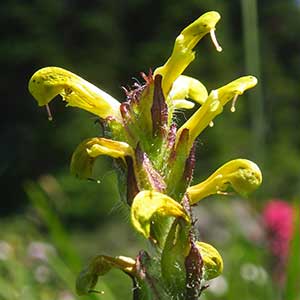Pedicularis rainierensis
Pedicularis ornithorhyncha
Mt. Rainier lousewort
bird's-beak lousewort, ducksbill lousewort
basal 2–5, blade lanceolate, 40–80 x 3–20 mm, 2-pinnatifid, margins of adjacent lobes nonoverlapping or slightly overlapping distally, serrate to 2-serrate, surfaces glabrous;
cauline 2–6, blade lanceolate, 15–70 x 5–20 mm, 1- or 2-pinnatifid, margins of adjacent lobes nonoverlapping or slightly overlapping distally, serrate, surfaces glabrous.
basal 2–10, blade lanceolate to oblanceolate, 15–80 x 3–10 mm, 1- or 2-pinnatifid, margins of adjacent lobes nonoverlapping or slightly overlapping distally, entire or serrate, surfaces glabrous;
cauline 0–4, blade lanceolate, 5–40 x 3–15 mm, 1- or 2-pinnatifid, margins of adjacent lobes nonoverlapping or slightly overlapping distally, serrate, surfaces glabrous.
simple, 1–4, exceeding basal leaves, each 10–50-flowered;
bracts lanceolate or subulate to trullate, 10–15 x 1–2 mm, undivided or pinnatifid, proximal margins entire, distal serrate, surfaces glabrous or tomentose.
simple, 1–5, exceeding basal leaves, each 4–15-flowered;
bracts trullate, sometimes lanceolate, 5–13 x 1–3 mm, +/- lobed, margins entire or serrate, surfaces glabrous or tomentose.
1–3.5 mm.
3–6 mm.
calyx 7.5–11 mm, hispid to tomentose, lobes 5, linear to narrowly triangular, 4–5 mm, apex entire, glabrous or ciliate;
corolla 16–19 mm, tube light or dark yellow, 8–10 mm;
galea light or dark yellow, 8–9 mm, beakless, margins entire medially and distally, apex arching beyond abaxial lip;
abaxial lip light or dark yellow, 4–5 mm.
calyx 6.5–9 mm, tomentose, lobes 5, triangular, 2.5–4 mm, apex entire or serrulate, glabrous or ciliate;
corolla 12–15 mm, tube lavender, 8–9 mm;
galea lavender, 4–6.5 mm, beaked, beak straight, 2–6.5 mm, margins entire medially and distally, apex extending beyond abaxial lip;
abaxial lip pink, 6–8 mm.
= 16.
Pedicularis rainierensis
Pedicularis ornithorhyncha
Pedicularis rainierensis is known from Mt. Rainier and the Crystal Mountain area. The species is easily confused with P. bracteosa var. latifolia, which often occurs in the same meadows. While the sizes and shapes of their flowers are nearly indistinguishable, P. rainierensis is a much smaller plant with leaves only about three fourths the size, proximal leaf lobes less than one fifth the size, inflorescences about one half the length, and the number of flowers greatly reduced in comparison to those of P. bracteosa var. latifolia.
(Discussion copyrighted by Flora of North America; reprinted with permission.)
Pedicularis ornithorhynchos is commonly misspelled in the literature as P. ornithorhyncha. As this is the orthography used in floras since C. L. Hitchcock et al. (1955–1969, vol. 4), it also appears on recent herbarium specimens. How this error arose is unclear because the same misspelling also appears on specimens older than 1959. Another occasional misspelling is ornithorhynchus.
The galeas of Pedicularis ornithorhynchos taper into long conical, uncoiled beaks that are very conspicuous above the horizontally expanded lateral lobes of the abaxial lips. No more than 15 flowers are borne on the capitate heads, with the internodes greatly expanding as the fruits develop. Compared to the basal leaves, the cauline leaves of the inflorescence are very few and much shorter, but otherwise similar in form. This alpine and tundra species occurs in the Alaskan panhandle and Coast Mountains as well as the coast ranges of mainland British Columbia south into the northern Cascade Range as far south as Mount Rainier; it is also recorded from alpine areas on Vancouver Island and the Haida Gwaii (Queen Charlotte Islands), British Columbia.
Pedicularis ornithorhynchos is pollinated by bumblebees that hang inverted from the galea and cause release of pollen by wing-muscle vibrations (L. W. Macior 1973).
(Discussion copyrighted by Flora of North America; reprinted with permission.)


